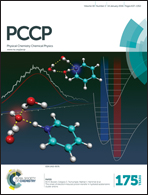Engineering of hydrogenated two-dimensional h-BN/C superlattices as electrostatic substrates†
Abstract
Hybridized two-dimensional materials incorporating domains from the hexagonal boron nitride (h-BN) and graphene is an interesting branch of materials science due to their highly tunable electronic properties. In the present study, we investigate the hydrogenated two-dimensional (2D) h-BN/C superlattices (SLs) with zigzag edges using first-principles calculations. We found that the domain width, the phase ratio, and the vertical dipole orientation all have significant influence on the stability of SLs. The electronic reconstruction is associated with the lateral polar discontinuities at the zigzag edges and the vertically polarized (B2N2H4)m domains, which modifies the electronic structures and the spatial potential of the SLs significantly. Furthermore, we demonstrate that the hydrogenated 2D h-BN/C SLs can be applied in engineering the electronic structure of graphene: laterally-varying doping can be achieved by taking advantage of the spatial variation of the surface potential of the SLs. By applying an external vertical electric field on these novel bidirectional heterostructures, graphene doping levels and band offsets can be tuned to a wide range, such that the graphene doping profile can be switched from the bipolar (p–n junction) to unipolar (n+–n junction) mode. It is expected that such bidirectional heterostructures provide an effective approach for developing novel nanoscale electronic devices and improving our understanding of the fundamentals of low-dimensional materials.


 Please wait while we load your content...
Please wait while we load your content...